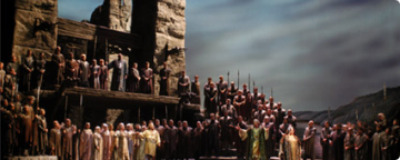On assignment for The Wall Street Journal, I recently spent a day at the opera. Arriving at the Metropolitan Opera house around 9:30 a.m. in late April, I watched as sets were set up, rehearsals conducted, wigs made, costumes sewn, and so on. The resulting article is in today’s paper. You can read it here.
It was a fascinating day. In the space of 24 hours, the Met took down sets for Don Giovanni performance, put up sets for a staged rehearsal of Act III of Gotterdammerung and then “struck” them by 4 p.m., and then, in late afternoon, assembled the sets for Il Trovatore, which ran at 8 p.m. that night. And that’s just the start of what goes on inside the Met, 24/6 — and sometimes 24/7.

Under Peter Gelb, the Met has been more open, simulcasting opening night to Times Square and sometimes inviting the public in to see rehearsals. That’s to be applauded. But the experience I had watching a rehearsal of Gotterdammerung (above) — standing below/behind the Rhinemaidens as they opened Act III, for example; seeing/hearing the mist descend on the stage to keep the dust down; watching director Otto Schenk approvingly touch the cheek of soprano Margaret Jane Wray as he walked past her, just off-stage — gives an ever greater appreciation for what’s involved in making opera, logistically and in human terms. That why it’s great to be a journalist.
Photo: Courtesy Metropolitan Opera
